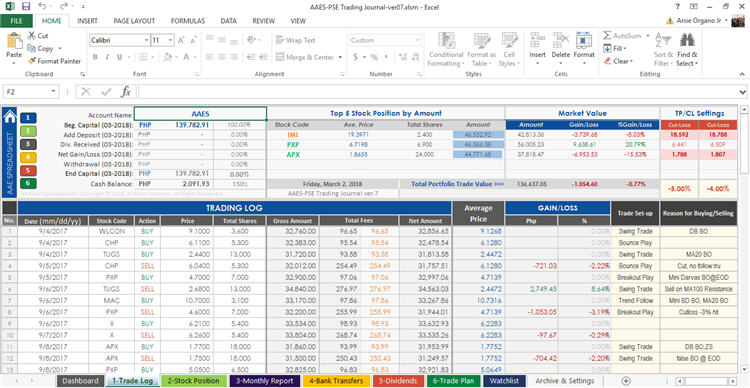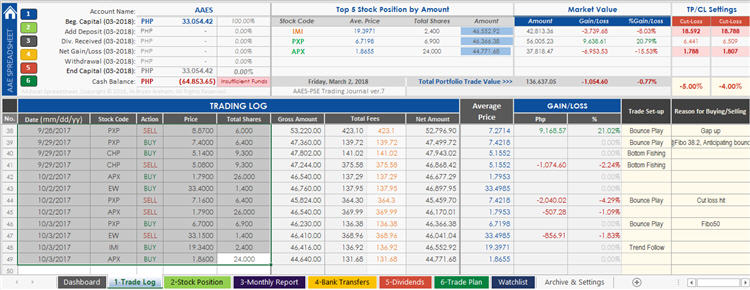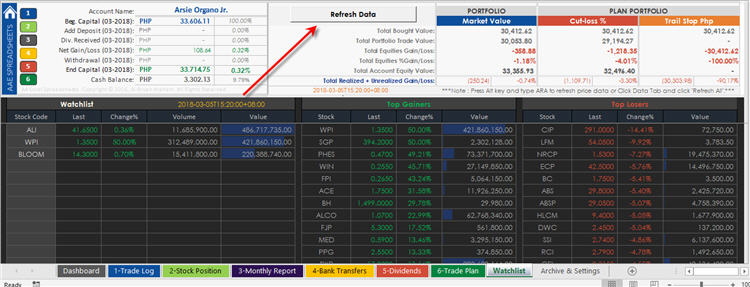Page Contents
What is a Trading Journal Spreadsheet?
What exactly do we mean by a trading journal spreadsheet? Why is it that important in our trading activities? What does it do or what do we gain from having our own trading journal spreadsheet? Does it improve our trading skills? These and many other questions are commonly being asked when you try to introduce a tool. That is why we will try to give you a high-level information about the importance of having your own trading journal spreadsheet. And how can a simple tool like this can improve your trading skills. So, let’s start?
In a nutshell, a trading journal spreadsheet is a file created from software like Microsoft Excel. Basically, this tool is designed to help traders to go back to their past trades or transactions for review. Successful traders can further analyze from the data what went right and what went wrong. Having this kind of analysis will strengthen the trader’s trading skills. From the experience and data analysis, the successful trader can improve his strategy for the succeeding transactions. Does it makes sense now?
So, what does a trading journal spreadsheet look like? Here’s an example template created by AA Excel Spreadsheets which I find very useful. The author was kind enough to send me the latest version for review.
Update [24APR2018]: Oppps! There’s an updated version now of PSE Trading Journal Spreadsheet here!

PSE Trading Journal Spreadsheet ver.7 – Trial Version
The spreadsheet above may seem complicated as it looks – but it is not! Let us show you the good stuffs of this trading journal spreadsheet from AAES.
How to use AAES Trading Journal Spreadsheet for PSE
AAES’ trading journal spreadsheet (ver.7) currently have 9 sheets as you can see in the image above. Let’s tackle and discuss each sheets and what’s their significance or use.
Dashboard

Dashboard – Trading Journal Spreadsheet from AAES
The first sheet is named as Dashboard. This sheet will serve as your main portfolio summary. From here, you will be able to view quickly the summary of your trades like the number of trades, ratio between your wins and losses, and your trade setup. From your Dashboard sheet, you will also see your quarterly, monthly, and annual report. The data here are automatically populated from the inputs you will put from the other sheets.
Trade Log

Trade Log Trading Journal Spreadsheet from AAES
Then we have the Trade Log sheet. This is where you input your buy and/or sell transactions.
How to use the Trade Log sheet
Here are some inputs on how to use the Trade Log sheet and it’s functionalities:
- Input your buy/sell transactions under the Trading Log.
- The Fees are automatically computed based on the standard fees for most Trading platforms. But in case that there are fee corrections, like in IPO or Mutual fund trades then you can manually indicate the fees. Also use to backup original fees in case of changes in fees or taxes.
- Record your decision making on each trades, add notes and trades setups.
- Automated cutloss and target price settings by %, Enter positive % value for target price or enter negative % value for cutloss price.
Stock Position and Monthly Report Sheets

Stock Position Trading Journal Spreadsheet from AAES

Monthly Report Trading Journal Spreadsheet from AAES
Stock Position and Monthly Report sheets are another summary table of your trading – in a little more detailed as compared to your Dashboard. The data here are automatically populated based from your inputs. The Stock Position sheet will automatically sort your traded stocks showing you your top gainers and losers. While the Monthly Report sheet will show you your Cumulative Capital Growth – Initial investment, additional capital, Withdrawals, gains, loss, cash dividends, and end capital.
Bank Transfers

Bank TransfersTrading Journal Spreadsheet from AAES
Bank Transfers sheet is the place where you manually input all of your deposits/withdrawals from your trading funds. It will automatically compute and show you the totals of your transactions.
Dividends

DividendsTrading Journal Spreadsheet from AAES
The Dividends sheet is mainly intended for cash dividends and not Stock dividends. Cash dividends are commonly noted as cash payment from a company to their shareholders which is further explained in Investopedia.
Trade Plan

Trade Plan – Trading Journal Spreadsheet from AAES
So what does this Trade Plan sheet can do for you? According to the author, here are the functionalities and how you can use the Trade plan sheet.
- Manual Last Traded Price (LTP) option, in case real-time market price doesn’t work. any value input will overwrite the auto price column.
- Cutloss,Target price and Trail stop calculation by %: Enter desired percentage for each settings.
- Trail stop price: Enter exact trail stop price based on your technical analysis.
- Plan portfolio preview option: Select from options to preview your portfolio value once your plan has been executed.
Watchlist

Watchlist – TransfersTrading Journal Spreadsheet from AAES
The Watchlist sheet is somehow similar to what we call wish list. You can input all your target stock(s) for your next plan – either to buy/sell. That is not the only purpose of this sheet. It can automatically populate the real-time prices of the stocks – both your watchlists and gainers/losers for the day.
Currently, I am using the trial version so I have to manually trigger the Refresh button from Data tab for me to get the latest stock prices. In the full version, there is an actual Refresh button that can be used to capture again the stock prices data.
But once you get the chance you use the full version of AAES Trading Journal Spreadsheet, you will get that “Refresh Data” button.

Watchlist Full Version – Trading Journal Spreadsheet from AAES
Archive and Settings

Archive and Settings – Trading Journal Spreadsheet from AAES
The Archive & Settings sheet will enable you to update your broker’s fee in case they change it overtime. Currently, the fee settings there is the default one almost all brokers are using as of the moment. Also, you can backup your journal from this sheet – for safekeeping.
Summary
If you are serious about trading and you want to organize the way you trade, then having your own copy of a trading journal spreadsheet is not a bad idea at all. And this Trading Journal spreadsheet from AAES, if you don’t have time to create your own, is a good tool. However, if you will use the trial-version then you will only be limited with 50 rows entry in the Trade log. This maybe fine if you are not a heavy trader – especially a day trader. Day traders usually does multiple of trading transactions in a day. If this is the case, then you might need to get the full version.
As of writing this, I have no clue as of the moment on the pricing plans and support if you are interested getting the full version. You can try to reach the author itself on AAES official Facebook page.
I will continue to use the trial version for now since I am more focused on how to profit from mining cryptocurrency through Hashflare. 🙂
